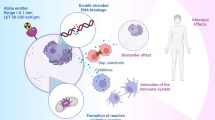Abstract
In this study, three 18F-labeled crown ether fused anilinoquinazoline derivatives ([18F]11a–c) were synthesized and evaluated as potential tumor imaging probes. The biodistribution results of [18F]11b were good. Compared with [18F]-fludeoxyglucose and l-[18F]-fluoroethyltyrosine in the same animal model, [18F]11b had better tumor/brain, tumor/muscle, and tumor/blood uptake ratios. Overall, these results suggest that [18F]11b is promising as a tumor imaging agent for positron emission tomography.



Similar content being viewed by others
References
Bansode V (2012) Synthesis and evaluation of some coumarin based Schiff’s bases as potential antimicrobial agents. E J Chem 9:2079–2088
Blum CA (2008) Aminoquinazolines as TRPV1 antagonists: modulation of drug-like properties through the exploration of 2-position substitution. Bioorg Med Chem Lett 18:4573–4577
Block MH (1992) The aminoquinazoline group as a replacement for the salicylamide group: the design and synthesis of a novel highly selective beta 1 adrenoceptor partial agonist. Drug Des Discov 9:167–176
Ciardiello F (2000) Antitumor effect and potentiation of cytotoxic drugs activity in human cancer cells by ZD-1839 (Iressa), an epidermal growth factor receptor-selective tyrosine kinase inhibitor. Clin Cancer Res 6:2053–2063
Nedergaard MK (2012) Targeting the epidermal growth factor receptor in solid tumor malignancies. Biodrugs 26:83–99
Stewart JSW (2009) Phase III study of Gefitinib 250 compared with intravenous methotrexate for recurrent squamous cell carcinoma of the head and neck. J Clin Oncol 27:3410–3410
Ren X (2005) Research progresses of epidermal growth factor receptor tyrosine kinase inhibitors. Chin J New Drugs 14:821–826
Gatzemeier U (2007) Phase III study of erlotinib in combination with cisplatin and gemcitabine in advanced non-small-cell lung cancer: the Tarceva Lung Cancer Investigation Trial. J Clin Oncol 25:1545–1552
Herbst RS (2005) A phase III trial of erlotinib hydrochloride (OSI-774) combined with carboplatin and paclitaxel chemotherapy in advanced non-small-cell lung cancer. J Clin Oncol 23:5892–5899
Burris HA (2005) Phase I safety, pharmacokinetics, and clinical activity study of lapatinib (GW572016), a reversible dual inhibitor of epidermal growth factor receptor tyrosine kinases, in heavily pretreated patients with metastatic carcinomas. J Clin Oncol 23:5305–5313
Mei DAI (2009) EGFR-targeted agents in cancer therapy. Chin Bull Life Sci 21:412–417
Castellino S (2012) Human metabolism of lapatinib, a dual kinase inhibitor: implications for hepatotoxicity. Drug Metab Dispos 40:139–150
Hu S (2012) Synthesis and biological evaluation of crown ether fused quinazoline analogues as potent EGFR inhibitors. Bioorg Med Chem Lett 22:6301–6305
Minkovsky N (2008) BIBW-2992, a dual receptor tyrosine kinase inhibitor for the treatment of solid tumors. Curr Opin Investig Drugs 9:1336–1346
Tan F (2012) Icotinib (BPI-2009H), a novel EGFR tyrosine kinase inhibitor, displays potent efficacy in preclinical studies. Lung Cancer 76:177–182
Shi Y (2013) Icotinib versus gefitinib in previously treated advanced non-small-cell lung cancer (ICOGEN): a randomised, double-blind phase 3 non-inferiority trial. Lancet Oncol 14:953–961
Tan F (2013) Safety and efficacy results of a phase IV, open-label, multicenter, safety-monitoring study of icotinib in treating advanced non-small cell lung cancer (NSCLC): iSAFE study. J Clin Oncol 31:15
Tan F (2015) Icotinib, a selective EGF receptor tyrosine kinase inhibitor, for the treatment of non-small-cell lung cancer. Future Oncol 11:385–397
Bonasera TA (2001) Potential F-18-labeled biomarkers for epidermal growth factor receptor tyrosine kinase. Nucl Med Biol 28:359–374
Abourbeh G (2007) Evaluation of radiolabeled ML04, a putative irreversible inhibitor of epidermal growth factor receptor, as a bioprobe for PET imaging of EGFR-overexpressing tumors. Nucl Med Biol 34:55–70
Su H (2008) Evaluation of F-18 gefitinib as a molecular imaging probe for the assessment of the epidermal growth factor receptor status in malignant tumors. Eur J Nucl Med Mol Imaging 35:1089–1099
Memon AA (2009) Positron emission tomography (PET) imaging with c-11 -labeled erlotinib: a micro-pet study on mice with lung tumor xenografts. Cancer Res 69:873–878
Tan F (2012) Icotinib (BPI-2009H), a novel EGFR tyrosine kinase inhibitor, displays potent efficacy in preclinical studies. Lung Cancer 76:177–182
Yang Y (2012) Application status and prospect of domestic drug: icotinib. J Pract Med 28(23):4016–4018
Hu S (2012) Synthesis and biological evaluation of crown ether fused quinazoline analogues as potent EGFR inhibitors. Bioorg Med Chem Lett 22:6301–6305
Wang, YX (2011) Icotinib hydrochloride, synthesis, crystalline forms, pharmaceutical compositions, and uses thereof. US20110182882[P]
Zhang S (2010) F-18 labeled benzimidazole derivatives as potential radiotracer for positron emission tomography (PET) tumor imaging. Bioorg Med Chem 18:2394–2401
Acknowledgments
We conducted this work with financial support from The National Natural Science Foundation of China (No. 21071022) and the Fundamental Research Funds for the Central Universities. In addition, we would like to thank the cyclotron operator team of the PET center of Xuanwu Hospital for providing the fluoride-18 nuclide.
Author information
Authors and Affiliations
Corresponding author
Electronic supplementary material
Below is the link to the electronic supplementary material.
Rights and permissions
About this article
Cite this article
Ren, H., Ning, H., Chang, J. et al. Evaluation of 18F-labeled icotinib derivatives as potential PET agents for tumor imaging. J Radioanal Nucl Chem 309, 517–523 (2016). https://doi.org/10.1007/s10967-015-4671-7
Received:
Published:
Issue Date:
DOI: https://doi.org/10.1007/s10967-015-4671-7




